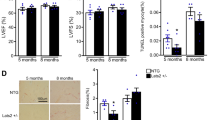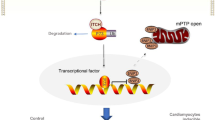Abstract
Clinical and experimental studies have shown an association between intracellular free Zn2+ ([Zn2+]i)-dyshomeostasis and cardiac dysfunction besides [Ca2+]i-dyshomeostasis. Since [Zn2+]i-homeostasis is regulated through Zn2+-transporters depending on their subcellular distributions, one can hypothesize that any imbalance in Zn2+-homeostasis via alteration in Zn2+-transporters may be associated with the induction of ER stress and apoptosis in hypertrophic heart. We used a transverse aortic constriction (TAC) model to induce hypertrophy in young male rat heart. We confirmed the development of hypertrophy with a high ratio of heart to body weight and cardiomyocyte capacitance. The expression levels of ER stress markers GRP78, CHOP/Gadd153, and calnexin are significantly high in TAC-group in comparison to those of controls (SHAM-group). Additionally, we detected high expression levels of apoptotic status marker proteins such as the serine kinase GSK-3β, Bax-to-Bcl-2 ratio, and PUMA in TAC-group in comparison to SHAM-group. The ratios of phospho-Akt to Akt and phospho-NFκB to the NFκB are significantly higher in TAC-group than in SHAM-group. Furthermore, we observed markedly increased phospho-PKCα and PKCα levels in TAC-group. We, also for the first time, determined significantly increased ZIP7, ZIP14, and ZnT8 expressions along with decreased ZIP8 and ZnT7 levels in the heart tissue from TAC-group in comparison to SHAM-group. Furthermore, a roughly calculated total expression level of ZIPs responsible for Zn2+-influx into the cytosol (increased about twofold) can be also responsible for the markedly increased [Zn2+]i detected in hypertrophic cardiomyocytes. Taking into consideration the role of increased [Zn2+]i via decreased ER-[Zn2+] in the induction of ER stress in cardiomyocytes, our present data suggest that differential changes in the expression levels of Zn2+-transporters can underlie mechanical dysfunction, in part due to the induction of ER stress and apoptosis in hypertrophic heart via increased [Zn2+]i- besides [Ca2+]i-dyshomeostasis.





Similar content being viewed by others
References
Prasad AS, Halsted JA, Nadimi M (1961) Syndrome of iron deficiency anemia, hepatosplenomegaly, hypogonadism, dwarfism and geophagia. Am J Med 31:532–546
Atar D, Backx PH, Appel MM, Gao WD, Marban E (1995) Excitation-transcription coupling mediated by zinc influx through voltage-dependent calcium channels. J Biol Chem 270(6):2473–2477
Korichneva I, Hoyos B, Chua R, Levi E, Hammerling U (2002) Zinc release from protein kinase C as the common event during activation by lipid second messenger or reactive oxygen. J Biol Chem 277(46):44327–44331. doi:10.1074/jbc.M205634200
Shokrzadeh M, Ghaemian A, Salehifar E, Aliakbari S, Saravi SS, Ebrahimi P (2009) Serum zinc and copper levels in ischemic cardiomyopathy. Biol Trace Elem Res 127(2):116–123. doi:10.1007/s12011-008-8237-1
Hashemian M, Poustchi H, Mohammadi-Nasrabadi F, Hekmatdoost A (2015) Systematic review of zinc biochemical indicators and risk of coronary heart disease. ARYA Atheroscler 11(6):357–365
MacDonald RS (2000) The role of zinc in growth and cell proliferation. J Nutr 130(5S Suppl):1500s–1508s
Turan B, Fliss H, Desilets M (1997) Oxidants increase intracellular free Zn2+ concentration in rabbit ventricular myocytes. Am J Physiol 272(5 Pt 2):H2095–H2106
Tuncay E, Bilginoglu A, Sozmen NN, Zeydanli EN, Ugur M, Vassort G, Turan B (2011) Intracellular free zinc during cardiac excitation-contraction cycle: calcium and redox dependencies. Cardiovasc Res 89(3):634–642. doi:10.1093/cvr/cvq352
Tuncay E, Okatan EN, Toy A, Turan B (2014) Enhancement of cellular antioxidant-defence preserves diastolic dysfunction via regulation of both diastolic Zn2+ and Ca2+ and prevention of RyR2-leak in hyperglycemic cardiomyocytes. Oxid Med Cell Longev 2014:290381. doi:10.1155/2014/290381
Murakami M, Hirano T (2008) Intracellular zinc homeostasis and zinc signaling. Cancer Sci 99(8):1515–1522. doi:10.1111/j.1349-7006.2008.00854.x
Woodier J, Rainbow RD, Stewart AJ, Pitt SJ (2015) Intracellular zinc modulates cardiac ryanodine receptor-mediated calcium release. J Biol Chem 290(28):17599–17610. doi:10.1074/jbc.M115.661280
Fukada T, Yamasaki S, Nishida K, Murakami M, Hirano T (2011) Zinc homeostasis and signaling in health and diseases: zinc signaling. J Biol Inorg Chem 16(7):1123–1134. doi:10.1007/s00775-011-0797-4
Eide DJ (2006) Zinc transporters and the cellular trafficking of zinc. Biochim Biophys Acta 1763(7):711–722. doi:10.1016/j.bbamcr.2006.03.005
Yang L, Zhao D, Ren J, Yang J (2015) Endoplasmic reticulum stress and protein quality control in diabetic cardiomyopathy. Biochim Biophys Acta 1852(2):209–218. doi:10.1016/j.bbadis.2014.05.006
Bellomo EA, Meur G, Rutter GA (2011) Glucose regulates free cytosolic Zn(2)(+) concentration, Slc39 (ZiP), and metallothionein gene expression in primary pancreatic islet beta-cells. J Biol Chem 286(29):25778–25789. doi:10.1074/jbc.M111.246082
Tuncay E, Okatan EN, Vassort G, Turan B (2013) ss-blocker timolol prevents arrhythmogenic Ca(2)(+) release and normalizes Ca(2)(+) and Zn(2)(+) dyshomeostasis in hyperglycemic rat heart. PLoS ONE 8(7):e71014. doi:10.1371/journal.pone.0071014
Zhao N, Gao J, Enns CA, Knutson MD (2010) ZRT/IRT-like protein 14 (ZIP14) promotes the cellular assimilation of iron from transferrin. J Biol Chem 285(42):32141–32150. doi:10.1074/jbc.M110.143248
Etzion Y, Ganiel A, Beharier O, Shalev A, Novack V, Volvich L, Abrahamov D, Matsa M, Sahar G, Moran A, Katz A (2008) Correlation between atrial ZnT-1 expression and atrial fibrillation in humans: a pilot study. J Cardiovasc Electrophysiol 19(2):157–164. doi:10.1111/j.1540-8167.2007.01008.x
Hashimoto A, Nakagawa M, Tsujimura N, Miyazaki S, Kizu K, Goto T, Komatsu Y, Matsunaga A, Shirakawa H, Narita H, Kambe T, Komai M (2016) Properties of Zip4 accumulation during zinc deficiency and its usefulness to evaluate zinc status: a study of the effects of zinc deficiency during lactation. Am J Physiol Regul Integr Comp Physiol 310(5):R459–R468. doi:10.1152/ajpregu.00439.2015
Lakshmanan AP, Harima M, Suzuki K, Soetikno V, Nagata M, Nakamura T, Takahashi T, Sone H, Kawachi H, Watanabe K (2013) The hyperglycemia stimulated myocardial endoplasmic reticulum (ER) stress contributes to diabetic cardiomyopathy in the transgenic non-obese type 2 diabetic rats: a differential role of unfolded protein response (UPR) signaling proteins. Int J Biochem Cell Biol 45(2):438–447. doi:10.1016/j.biocel.2012.09.017
Tuncay E, Bitirim VC, Durak A, Carrat GRJ, Taylor KM, Rutter GA, Turan B (2017) Hyperglycemia-induced changes in ZIP7 and ZnT7 expression cause Zn2+ release from the sarco(endo)plasmic reticulum and mediate ER stress in the heart. Diabetes 66(5):1346–1358. doi:10.2337/db16-1099
Ellis CD, Wang F, MacDiarmid CW, Clark S, Lyons T, Eide DJ (2004) Zinc and the Msc2 zinc transporter protein are required for endoplasmic reticulum function. J Cell Biol 166(3):325–335. doi:10.1083/jcb.200401157
Csermely P, Szamel M, Resch K, Somogyi J (1988) Zinc can increase the activity of protein kinase C and contributes to its binding to plasma membranes in T lymphocytes. J Biol Chem 263(14):6487–6490
Li W, Wang N, Li M, Gong H, Liao X, Yang X, Zhang T (2015) Protein kinase Cα inhibits myocardin-induced cardiomyocyte hypertrophy through the promotion of myocardin phosphorylation. Acta Biochim Biophys Sin 47(9):687–695. doi:10.1093/abbs/gmv067
Little PJ, Bhattacharya R, Moreyra AE, Korichneva IL (2010) Zinc and cardiovascular disease. Nutrition 26(11–12):1050–1057. doi:10.1016/j.nut.2010.03.007
Hughes S, Samman S (2006) The effect of zinc supplementation in humans on plasma lipids, antioxidant status and thrombogenesis. J Am Coll Nutr 25(4):285–291
Kalogeris T, Baines CP, Krenz M, Korthuis RJ (2012) Cell biology of ischemia/reperfusion injury. Int Rev Cell Mol Biol 298:229–317. doi:10.1016/b978-0-12-394309-5.00006-7
Tarnavski O (2009) Mouse surgical models in cardiovascular research. Methods Mol Biol 573:115–137. doi:10.1007/978-1-60761-247-6_7
Little E, Ramakrishnan M, Roy B, Gazit G, Lee AS (1994) The glucose-regulated proteins (GRP78 and GRP94): functions, gene regulation, and applications. Crit Rev Eukaryot Gene Expr 4(1):1–18
An WL, Bjorkdahl C, Liu R, Cowburn RF, Winblad B, Pei JJ (2005) Mechanism of zinc-induced phosphorylation of p70 S6 kinase and glycogen synthase kinase 3β in SH-SY5Y neuroblastoma cells. J Neurochem 92(5):1104–1115. doi:10.1111/j.1471-4159.2004.02948.x
Rao R, Hao CM, Redha R, Wasserman DH, McGuinness OP, Breyer MD (2007) Glycogen synthase kinase 3 inhibition improves insulin-stimulated glucose metabolism but not hypertension in high-fat-fed C57BL/6J mice. Diabetologia 50(2):452–460. doi:10.1007/s00125-006-0552-5
Miki T, Miura T, Hotta H, Tanno M, Yano T, Sato T, Terashima Y, Takada A, Ishikawa S, Shimamoto K (2009) Endoplasmic reticulum stress in diabetic hearts abolishes erythropoietin-induced myocardial protection by impairment of phospho-glycogen synthase kinase-3β-mediated suppression of mitochondrial permeability transition. Diabetes 58(12):2863–2872. doi:10.2337/db09-0158
Drews O, Tsukamoto O, Liem D, Streicher J, Wang Y, Ping P (2010) Differential regulation of proteasome function in isoproterenol-induced cardiac hypertrophy. Circ Res 107(9):1094–1101. doi:10.1161/circresaha.110.222364
Yaras N, Ugur M, Ozdemir S, Gurdal H, Purali N, Lacampagne A, Vassort G, Turan B (2005) Effects of diabetes on ryanodine receptor Ca release channel (RyR2) and Ca2+ homeostasis in rat heart. Diabetes 54(11):3082–3088
Davidson HW, Wenzlau JM, O’Brien RM (2014) Zinc transporter 8 (ZnT8) and beta cell function. Trends Endocrinol Metab 25(8):415–424. doi:10.1016/j.tem.2014.03.008
Flannick J, Thorleifsson G, Beer NL et al (2014) Loss-of-function mutations in SLC30A8 protect against type 2 diabetes. Nat Genet 46(4):357–363. doi:10.1038/ng.2915
Oteiza PI (2012) Zinc and the modulation of redox homeostasis. Free Radic Biol Med 53(9):1748–1759. doi:10.1016/j.freeradbiomed.2012.08.568
Oyadomari S, Mori M (2004) Roles of CHOP/GADD153 in endoplasmic reticulum stress. Cell Death Differ 11(4):381–389. doi:10.1038/sj.cdd.4401373
Nebert DW, Galvez-Peralta M, Hay EB, Li H, Johansson E, Yin C, Wang B, He L, Soleimani M (2012) ZIP14 and ZIP8 zinc/bicarbonate symporters in Xenopus oocytes: characterization of metal uptake and inhibition. Metallomics 4(11):1218–1225. doi:10.1039/c2mt20177a
Taylor KM, Morgan HE, Johnson A, Nicholson RI (2005) Structure-function analysis of a novel member of the LIV-1 subfamily of zinc transporters, ZIP14. FEBS Lett 579(2):427–432. doi:10.1016/j.febslet.2004.12.006
Chimienti F, Devergnas S, Favier A, Seve M (2004) Identification and cloning of a beta-cell-specific zinc transporter, ZnT-8, localized into insulin secretory granules. Diabetes 53(9):2330–2337
Solomou A, Philippe E, Chabosseau P, Migrenne-Li S, Gaitan J, Lang J, Magnan C, Rutter GA (2016) Over-expression of Slc30a8/ZnT8 selectively in the mouse alpha cell impairs glucagon release and responses to hypoglycemia. Nutr Metab 13:46. doi:10.1186/s12986-016-0104-z
Fujishiro H, Yano Y, Takada Y, Tanihara M, Himeno S (2012) Roles of ZIP8, ZIP14, and DMT1 in transport of cadmium and manganese in mouse kidney proximal tubule cells. Metallomics 4(7):700–708. doi:10.1039/c2mt20024d
Knapp LT, Klann E (2000) Superoxide-induced stimulation of protein kinase C via thiol modification and modulation of zinc content. J Biol Chem 275(31):24136–24145. doi:10.1074/jbc.M002043200
Braz JC, Bueno OF, De Windt LJ, Molkentin JD (2002) PKC alpha regulates the hypertrophic growth of cardiomyocytes through extracellular signal-regulated kinase1/2 (ERK1/2). J Cell Biol 156(5):905–919. doi:10.1083/jcb.20010806
Liu Q, Chen X, Macdonnell SM, Kranias EG, Lorenz JN, Leitges M, Houser SR, Molkentin JD (2009) Protein kinase Cα, but not PKCβ or PKCγ, regulates contractility and heart failure susceptibility: implications for ruboxistaurin as a novel therapeutic approach. Circ Res 105(2):194–200. doi:10.1161/circresaha.109.195313
Lyon RC, Zanella F, Omens JH, Sheikh F (2015) Mechanotransduction in cardiac hypertrophy and failure. Circ Res 116(8):1462–1476. doi:10.1161/circresaha.116.304937
Jou MY, Philipps AF, Lonnerdal B (2010) Maternal zinc deficiency in rats affects growth and glucose metabolism in the offspring by inducing insulin resistance postnatally. J Nutr 140(9):1621–1627. doi:10.3945/jn.109.119677
Kambe T, Fukue K, Ishida R, Miyazaki S (2015) Overview of inherited zinc deficiency in infants and children. J Nutr Sci Vitaminol 61(Suppl):S44–S46. doi:10.3177/jnsv.61.S44
Efeovbokhan N, Bhattacharya SK, Ahokas RA, Sun Y, Guntaka RV, Gerling IC, Weber KT (2014) Zinc and the prooxidant heart failure phenotype. J Cardiovasc Pharmacol 64(4):393–400. doi:10.1097/fjc.0000000000000125
Acknowledgements
The authors thank to The Scientific and Technological Research Council of Turkey (TUBITAK) for Grant SBAG-113S296.
Author information
Authors and Affiliations
Corresponding author
Ethics declarations
Conflict of interest
The authors have no financial disclosures that would be a potential conflict of interest with the current manuscript.
Ethical approval
All animals were handled in accordance to the Guide for the Care and Use of Laboratory Animals published by the US National Institutes of Health (NIH publication number 85-23, revised 1996). The protocol was approved by the Akdeniz University Experimental Animals Ethics Committee, with an approval reference number (2013.02.10).
Rights and permissions
About this article
Cite this article
Olgar, Y., Ozdemir, S. & Turan, B. Induction of endoplasmic reticulum stress and changes in expression levels of Zn2+-transporters in hypertrophic rat heart. Mol Cell Biochem 440, 209–219 (2018). https://doi.org/10.1007/s11010-017-3168-9
Received:
Accepted:
Published:
Issue Date:
DOI: https://doi.org/10.1007/s11010-017-3168-9




